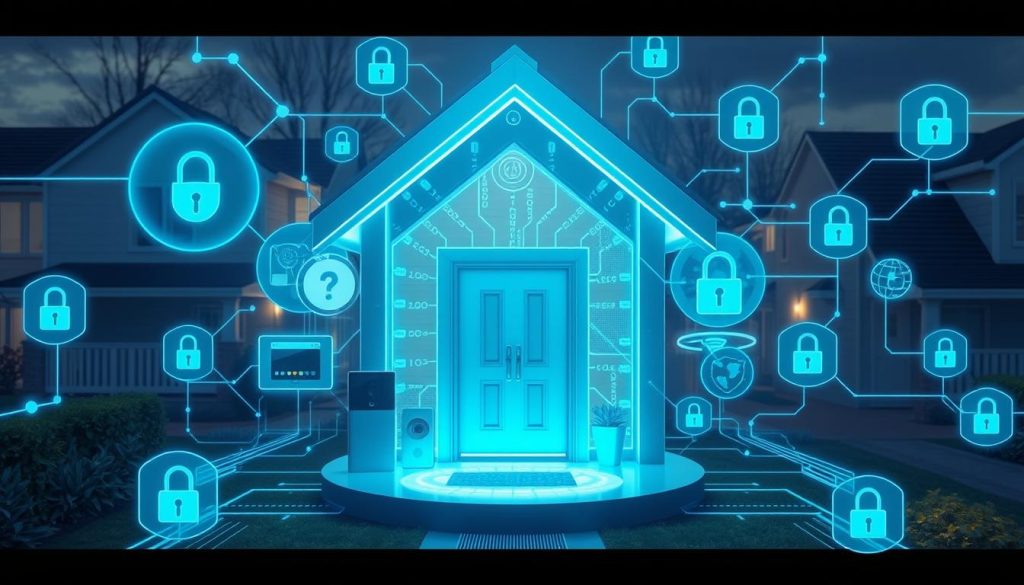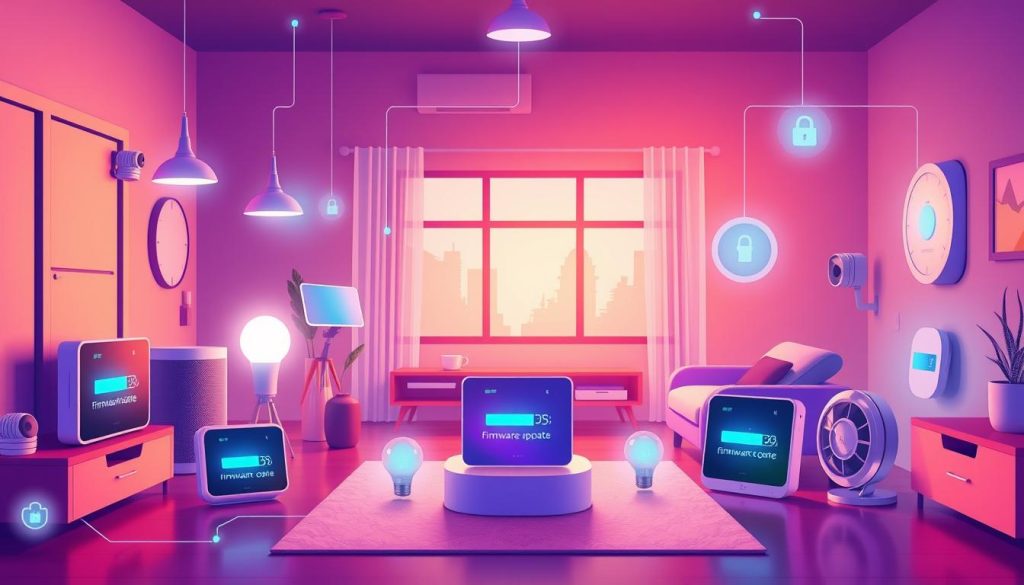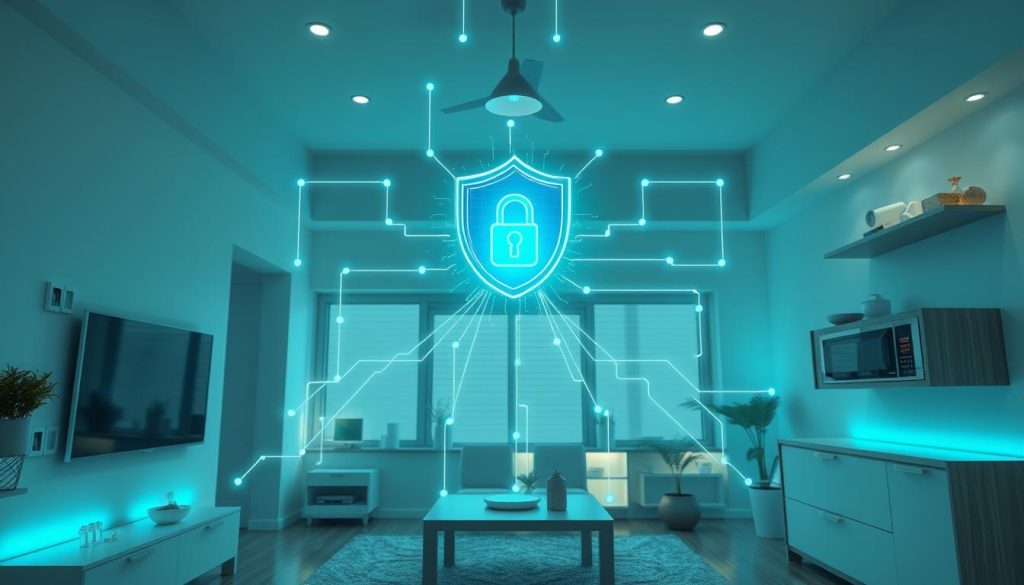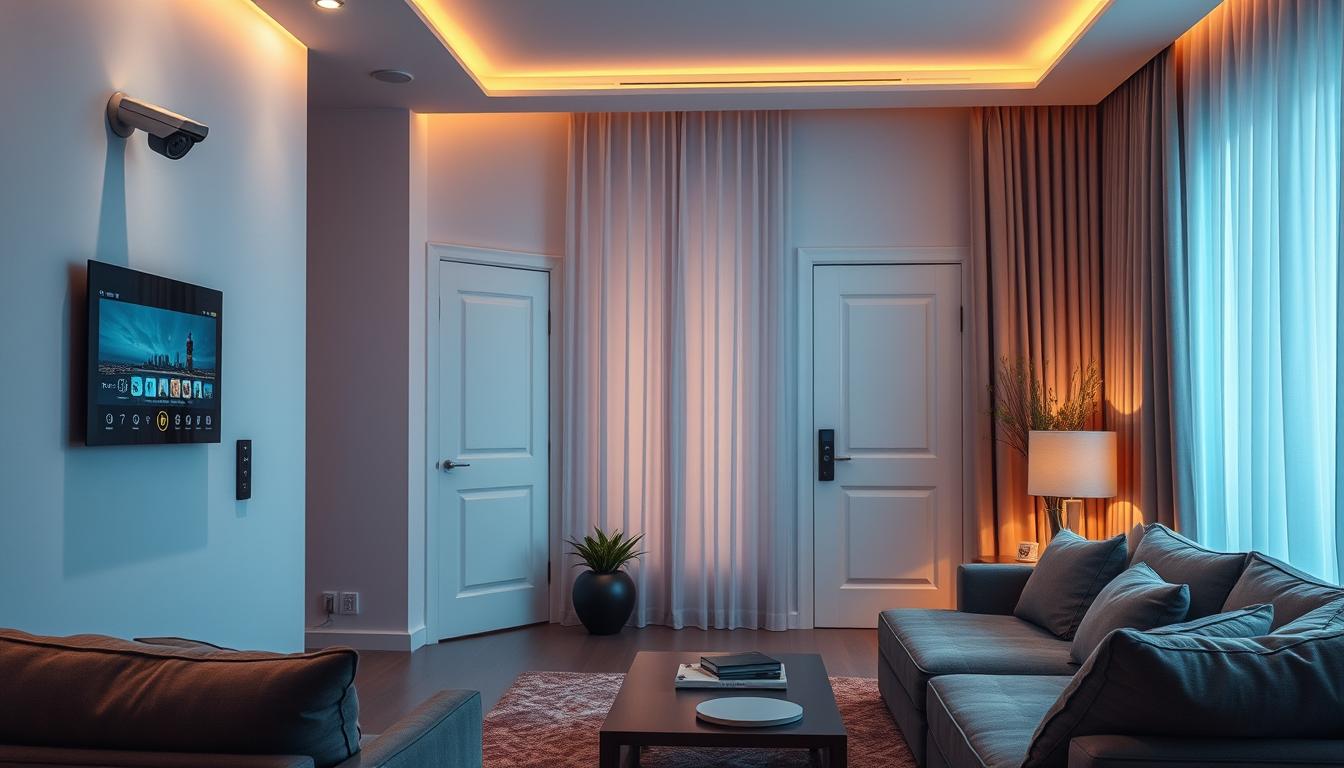Protecting my home and family is a top priority. In today’s world, learning how to secure your smart home is key. With more connected devices, it’s vital to take smart home security seriously to avoid cyber threats. This guide will show you how to keep your smart home safe, starting with the basics.
Knowing the risks of connected devices is crucial for protecting our digital privacy. By following smart home security tips, we can lower the risk of cyber attacks and data breaches.
In this guide, I’ll share my knowledge on securing your smart home. We’ll cover choosing the right devices and brands, using strong passwords and two-factor authentication, and keeping device firmware and software up to date. By doing these things, we can keep our smart homes safe from threats.
Understand the Basics of Smart Home Security
To keep your smart home safe, it’s key to know what a smart home is. It’s a house with internet-connected appliances, lights, and heating systems. These connections bring risks like weak passwords and unsecured networks.
Protecting your smart home is vital to stop unauthorized access. Smart homes face several risks, including:
- Weak passwords and authentication
- Outdated software and firmware
- Unsecured networks and devices
Knowing these risks helps you take action to boost your home’s security. Use strong passwords, update your software, and secure your networks.
By doing these things, you can safeguard your smart home from threats. Remember, keeping your home secure is an ongoing task. It needs regular checks and updates to stay safe.
Choose the Right Devices and Brands
Building a smart home means picking devices and brands that focus on security. I look for smart home devices with security features like encryption and secure boot. This keeps my home safe from threats.
To make good choices, I consider a few things:
- Reputation of the brand: I check the brand’s history and their commitment to IoT security.
- Security features: I search for devices with encryption, secure boot, and regular updates.
- Customer reviews and ratings: I read what others say to understand the device’s performance and security.
Brands like Samsung, Apple, and Google are known for their secure smart home devices. They focus on IoT security and keep their devices updated to protect against threats.
Choosing the right devices and brands helps keep my smart home safe. It’s important to focus on IoT security and protect my home from vulnerabilities.
| Brand | Security Features | Customer Reviews |
|---|---|---|
| Samsung | Encryption, secure boot mechanisms | 4.5/5 |
| Apple | Encryption, regular software updates | 4.7/5 |
| Encryption, secure boot mechanisms, regular software updates | 4.5/5 |
Install Strong Passwords and Two-Factor Authentication
To keep your smart home safe, use strong passwords and two-factor authentication. This is key to stopping unauthorized access. Make sure each device has a unique and complex password. Avoid simple patterns or easy-to-guess info.
For strong passwords, mix uppercase and lowercase letters, numbers, and special characters. This makes it hard for hackers to get in. Two-factor authentication adds more security. It asks for a code sent to your phone or email, along with your password.
Create Unique Passwords
- Use a password manager to generate and store complex passwords
- Avoid using the same password for multiple devices
- Update your passwords regularly to maintain smart home protection
Benefits of Two-Factor Authentication
Two-factor authentication adds extra security to your devices. It makes it harder for hackers to get in. This reduces the risk of unauthorized access to your smart home.

By following these tips, you can protect your smart home devices. Use strong passwords and two-factor authentication. This gives you peace of mind and better security for your connected devices.
| Device | Password Requirements | Two-Factor Authentication |
|---|---|---|
| Smart Thermostat | Complex password with uppercase and lowercase letters, numbers, and special characters | Enabled |
| Security Camera | Unique password with a minimum of 12 characters | Enabled |
| Smart Door Lock | Complex password with a combination of letters, numbers, and special characters | Enabled |
Regularly Update Device Firmware and Software
To keep your smart home devices safe, updating their firmware and software is key. This is vital for IoT and home automation security. Outdated devices can be at risk of cyber threats. Regular updates help fix vulnerabilities and stop attacks.
Updating your devices is easy. Look for the update option in the settings menu. It’s smart to turn on automatic updates. This way, you won’t have to manually update each time.
Here are some benefits of regular updates:
- Improved security: Updates patch new vulnerabilities, protecting your devices from threats.
- Enhanced performance: Updates make your devices faster and more efficient.
- New features: Updates add new features, improving your smart home experience.

By updating your devices regularly, you keep your smart home safe and secure. This is crucial for maintaining your home automation and IoT security systems.
| Device Type | Update Frequency |
|---|---|
| Smart Thermostats | Every 2-3 months |
| Security Cameras | Every 1-2 months |
| Smart Speakers | Every 3-6 months |
Monitor Your Network and Devices
To keep your smart home network safe, it’s key to watch your network and devices closely. This lets you spot and fix security threats early. Being proactive helps you find and fix weak spots, keeping your smart home safe.
Monitoring means using tools to scan your network for odd activity. Look for strange login attempts, unknown devices, or sudden changes in settings. Catching these issues early helps protect your smart home.

- Regularly check device security settings to make sure they’re current and right.
- Use network security tools to find vulnerabilities and spot threats.
- Keep an eye on network activity to find any odd behavior.
By following these steps and staying alert, you can keep your smart home network and devices safe. This gives you peace of mind and helps avoid security problems.
Enable Encryption on Your Devices
To keep your data safe, it’s key to encrypt your devices. Encryption turns your data into a code that only the right key can unlock. This is crucial for smart home devices, as they hold sensitive info.
Encrypting your data means your info stays safe even if your devices get hacked. Many devices, like phones and laptops, have encryption features. For example, you can turn on full-disk encryption on your computer or use a VPN to encrypt your internet.
What is Encryption?
Encryption protects data by coding it. Only the right key can unlock it. This makes your data useless to anyone who tries to access it without permission.
How to Enable it on Common Devices
It’s easy to turn on encryption on your devices. Here’s how to do it for some common ones:
- Smartphones: Go to your phone’s settings, select “security” or “privacy,” and look for the encryption option.
- Computers: Search for “encryption” in your computer’s settings and follow the prompts to enable full-disk encryption.
- Routers: Log in to your router’s web interface and look for the encryption settings, usually found in the “wireless” or “security” section.

By following these steps, you can boost your smart home’s security. Always choose secure devices and keep your software updated. This will help protect your data from unauthorized access.
| Device | Encryption Method |
|---|---|
| Smartphone | Full-disk encryption |
| Computer | Full-disk encryption |
| Router | WPA2 encryption |
Set Up a Guest Network for Visitors
To boost your smart home’s security, setting up a guest network is key. This network lets visitors use the internet safely, without risking your main network’s security. It keeps your devices and personal info safe from unauthorized access.
A guest network offers many benefits, like better security and less chance of unauthorized access. Here are some main advantages:
Benefits of a Guest Network
- Improved security: It keeps visitors from getting into your main network and devices.
- Reduced risk: It lowers the chance of unauthorized access to your devices and personal info.
- Easy to set up: Most routers make it simple to create a guest network, enhancing your smart home’s security.
To make a guest network, just follow these steps:
Steps to Create a Guest Network
- Log in to your router’s settings page.
- Find and turn on the guest network settings.
- Choose a strong password for the guest network.
- Set up the guest network to keep it separate from your main network.
By doing these steps, you can make a safe guest network. This boosts your smart home’s security. Don’t forget to update your router’s firmware and software regularly for the latest security updates.
| Network Type | Security Level |
|---|---|
| Guest Network | High |
| Main Network | Very High |
Educate Yourself on Phishing and Scams
To keep your smart home safe, learning about phishing and scams is key. Phishing can let hackers into your home network, stealing your info and devices. Knowing these threats helps you stay ahead and protect your smart home.
Phishing often comes in emails or messages asking for your login or money details. These scams pretend to be from trusted places like banks or big companies. But, they’re actually trying to trick you into sharing your private info.
Recognizing Phishing Attempts
Spotting phishing is easy if you know what to look for. Watch out for spelling errors, weird links or attachments, and requests for your personal or financial info. Also, check the sender’s email to make sure it’s legit.
Protecting Your Personal Information
Keep your info safe by using strong, unique passwords for all accounts. Also, turn on two-factor authentication whenever you can. This adds an extra layer of security by needing a code sent to your phone or email. These steps greatly lower the risk of your smart home being hacked.
Learning about phishing and scams helps safeguard your smart home and personal info. Always be careful with emails or messages asking for sensitive info. And never click on suspicious links or open attachments from unknown sources.
By following these tips, you can shield your smart home from phishing and scams. This keeps your network and personal info safe from cyber threats.
Create an Emergency Response Plan
No smart home is fully protected without an emergency response plan. Creating a comprehensive plan helps you handle security breaches or unexpected incidents. Include details like who to contact, how to secure devices, and how to restore your system.
What to Include in Your Plan
Your emergency response plan should cover various scenarios, like data breaches and power outages. Make sure to include emergency contact numbers, device reset instructions, and backup storage locations for your data.
Testing Your Emergency Response Plan
After creating your plan, test it regularly. Conduct drills to find any gaps or areas for improvement. This ensures you can respond quickly and effectively in an emergency.
Creating and maintaining an emergency response plan is crucial for protecting your smart home and personal information. Stay vigilant and seek professional help if you have security concerns about your connected devices.


